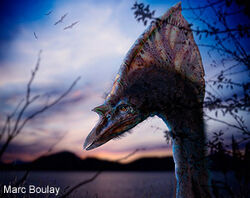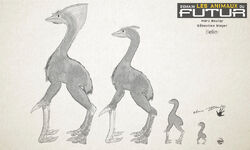
The male Giraffornis is impressive. It reminds us that these large quadrupeds are cousins of the 21st century white-fronted goose (Anser albifrons).

Growth of young Giraffornis is fast. As in the sauropod dinosaurs, this accelerated development probably allows to achieve raissonable size fairly quickly and so limit any predator attacks (such as of Tyrannornis).
Systematic: Aves (Bird), Anseriformes, Anatidae (ducks group, geese, swans)
Etymology: Of "Giraffe", giraffe, and "ornis" the bird. The species is dedicated to Dr. Gert van Dijk
Cousin of the XXI century: The white-fronted goose (Anser albifrons).
Height: 5 meters for females and 6 meters for males.
Distribution: Giraffornis vandijki live the great plains and savannas EurAfrican.
Morphology: This unique giant bird is a quadruped: its wings have turned into walking legs, very long and thin. The neck, very developed, ends with a rather flat head. The male sports a crest on the head and neck.
Ethology: Like its cousin of the 21st century, the white-fronted goose, Giraffornis vandijki is exclusively herbivorous. It even spends most of its time grazing, the crop acting as a paunch to ferment food. These unusual birds have retained the acute and short cry from their current cousins: their morning laughter defining nesting areas are, in the wet season, particularly impressive.
Reproduction: Monogamous couples stay together for several years. Eggs (5-6 year) are laid in simple holes dug in the ground. The male effectively protects the nest while the female incubates.
Conservation status: The Giraffornis is least concern.
By 5 million years (the 50020th Century)
They love to attack the travelers of the stars.
First, like a lion, the Giraffornis will stalk the travelers of the stars and then POUNCE like a leopard and bring the traveler of the star down like lions to a zebra and tigers to a peacock.
